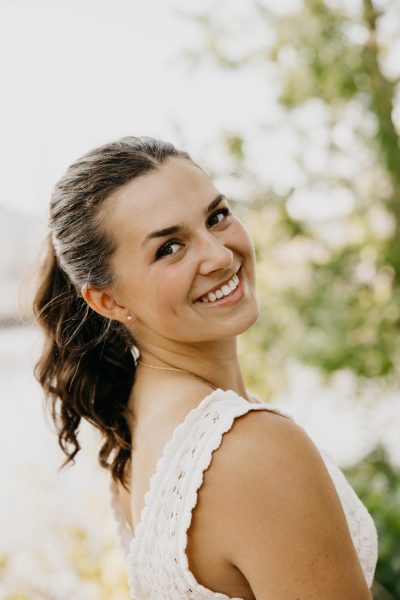Not a day goes by in the halls of Visitation School where Taylor Swift is not mentioned nor her songs not played on a school computer’s Spotify. After her, the US leg of her Eras Tour took the country by storm during the summer and the world tour just beginning, how could one not spend time enamored by her meticulously designed set pieces or ogle over her playful easter eggs? Although Swift’s lyrical genius has been a topic of conversation for years, the most recent transformation of this discussion has drifted to which of Swift’s Eras one identifies with the most. Comments such as “I’m such a Midnight’s girl” or “The falling leaves are so Folklore” have been making their way into daily conversation. Not only this but social media has taken a turn, with Instagram posts with topics such as “Your Taylor Swift Era based on your Zodiac Sign” or TikToks enlightening viewers with “Taylor Swift Eras as fruit.” With all of this, one can’t help but notice that exploring Taylor Swift’s diverse discography has a similar feel to the assorted school divisions at Visitation – all engulfed under one larger umbrella, but each with different nuances, purposes, and values. With that being said, I give you, each Visitation School subject division as a Taylor Swift Era:
Religion Department
With Salesian Spirituality and Catholic tradition being the cornerstone of Visitation School, it would only be fitting that the Religion Department is the Era that started it all, Taylor Swift’s Debut Era. Just like her inaugural self-titled album, Taylor Swift, Religion at Visitation School is a critical, well-loved subject. In this album, Taylor put herself on the map, just as Visitation’s founders did, with the purpose of creating a religious community so long ago. Swift uses her beginning album to explore identity through the lens of her relationships with others. This same theme is present in Religion classes of all divisions at Visitation, as “Eclisiology” and “Morality” alike teach students about the Catholic identity across time through productive discourse and relationships with classmates and people of the world. Even though Swift’s first album was released just shy of 20 years ago it, just like the subjects of Religion at Visitation stays poignant throughout the years, speaking to the importance of staying authentic to one’s humble beginnings.
Fine Arts Department
Fine Arts at Visitation can be heard in the choir and orchestra rooms, seen on the tagboards of the Art Suite and performed in DeSales, creating a perpetual theatrical performance within the brick walls of Visitation. Such a theatrical presence is also seen in Swift’s Speak Now album. Just as any actress, artist or musician at Visitaiton claims the pieces they produce, so too did Taylor as Speak Now marked the first album she wrote entirely by herself. Thus, the Speak Now Era marks a moment of personal expression and confession, just as the brushstrokes on a painting or notes hummed express the truth of their creators. In this album, Taylor Swift created her own fantasy through songs such as “Enchanted” or “Speak Now” just as artists and performers at Visititon and their teachers create their own worlds and stories through their works. And of course, in her Speak Now Era Swift continued to write the number 13 on her hand during performances, the equivalent of her maker’s mark or signature.
Science Department
There is nothing that makes you think of science more than experiments, whether it be lighting bunson burners in Mrs. Millers lab or performing titrations with Mrs. Turnau, science class is all about trying new methods to see what works and finding new ways and results. Swift adopted this approach with her album Red. The Red Era was Taylor Swift’s time in the lab, as she experimented with new aesthetics in her dress and new genres with her sound. Like how science at Visitation builds of the discoveries of the past, Swift adapted to the times by blending her country roots with modern pop and transitioned to a more mature style from her previous “fairy-tale” ballgowns. In her lyrics Swift speaks to about being in multiple states and having an array of feelings, so too is the division of science, as Visitation students learn to view the world from a preceptive of biology, physics, chemistry, etc; each a new method to achieving a similar goal. Taylor’s trial in Red, like the beginnings of science, set her up for notable success in the pop industry in later albums, demonstrating the importance of reinvention, experimentation, and personal evolution common to both Swift and science.
Language Department
Learning a foreign language is a new transformation, going from speaking and expressing oneself with ease to being incredibly deliberate about the words you say and the order in which they are said. In a sense, one is learning to reinvent themselves, their perspectives, and their way of thinking. So too did Taylor Swift when creating her 1989 album. Swift’s 1989 Era marked her full transition from country to pop music, just as a student of foreign language transitions from creating in the genre of their native language to something foreign. The aesthetic and themes of 1989 follow the freedom and excitement that come with growing up, similar to how one, “re-grows up” when learning a new language as one follows the same step they did as a child. Furthermore, Swift’s hit song “Welcome to New York” on the 1989 album explores the freedom and positive promise of change, a feeling akin to students in world language, as they too learn to navigate a new world.
Social Studies
Social Studies at Visitation is vast, covering historical modern realities of our societies and world but the one thing that connects all of these fields of study is that they are all uniquely human and our own. So too, is Taylor Swift’s Lover album. Lover is the first album that Taylor Swift exclusively owned, just as the history of ourselves and our communities cannot be taken away. Furthermore, the Lover Era marked a transition from the dark, edgy, and vengeful tone of her previous album, Reputation, showing a rebirth from her previous persona. Social Studies courses at Visitation follow a similar approach, as new understandings emerge from even the darkest of situations. Furthermore, Swift’s Lover Era marked a period of political activism for the singer, as she used her hit single, “You Need to Calm Down” to advocate for LGBTQ+ rights. Like Swift’s Lover Era, Social Studies courses include the most accounts of historical and modern activism among all divisions at Visitation and encourage students to form their beliefs and stand by them.
English Department
There is nothing that makes you want to curl up with a hot cup of tea more than a good book… oh, and the Folklore and Evermore albums. Released just five months apart, the two albums have parallel autumnal and cottage-core vibes and mark a change in Swift’s writing style from writing autobiographical songs to singing about the stories of other people and characters. Because of her eloquent storytelling on both albums, it would be a crime not to say that Visitation English Department is Swift’s Evermore/Folklore Eras. I mean… Mrs. Sutton’s classroom just screams Folklore and Evermore with its dimmed lights, couches, and slue of blankets for the taking. Writing these albums during the COVID-19 pandemic, Swift used her music as a vehicle for her to reflect and escape from the world around her. When releasing Folklore Swift posted on Instagram, “In isolation, my imagination has run wild and this album is the result, a collection of songs and stories that flowed like a stream of consciousness. Picking up a pen was my way of escaping into fantasy, history, and memory. I’ve told these stories to the best of my ability with all the love, wonder, and whimsy they deserve.” Like Folklore and Evermore literature provides its authors and readers with a chance to escape, delve into the stories of others, and reflect on the past and present. Whether the vehicle is just shy of three minutes or five hundred pages, Folklore/Evermore and the Visitation English courses explore the beauty that lies in sharing timeless narratives.
Mathematics Department
If you’ve ever found yourself up in the midnight hours on a school night, there’s a high probability that you were seated at the kitchen table, hunched over graph paper riddled with eraser shrapnel and unfinished problems. (There most likely had also been your dad standing over saying that they “changed math,” but that’s aside the point) Like these late-night mathematics endeavors, Taylor Swift, too found herself working in the ungodly hours of the night when writing her Midnights Album. So it’s only natural that the Math department at Visitation is Swift’s Midnights Era. Moreso than just the time the two are completed, Midnights and mathematics both strive to solve problems and understand phenomena, as Swift writes about trying to understand herself and the feelings that keep her up at night. Furthermore, the retro/vintage aesthetic of the Midnights Era mixed with the modern vocals perfectly aligns with the Visitation School approach to math, applying old theorems, laws, and equations to the modern world. So whether it’s proving that shape is a triangle or questioning one’s insecurities, both math and Midnights will keep you up wondering.






